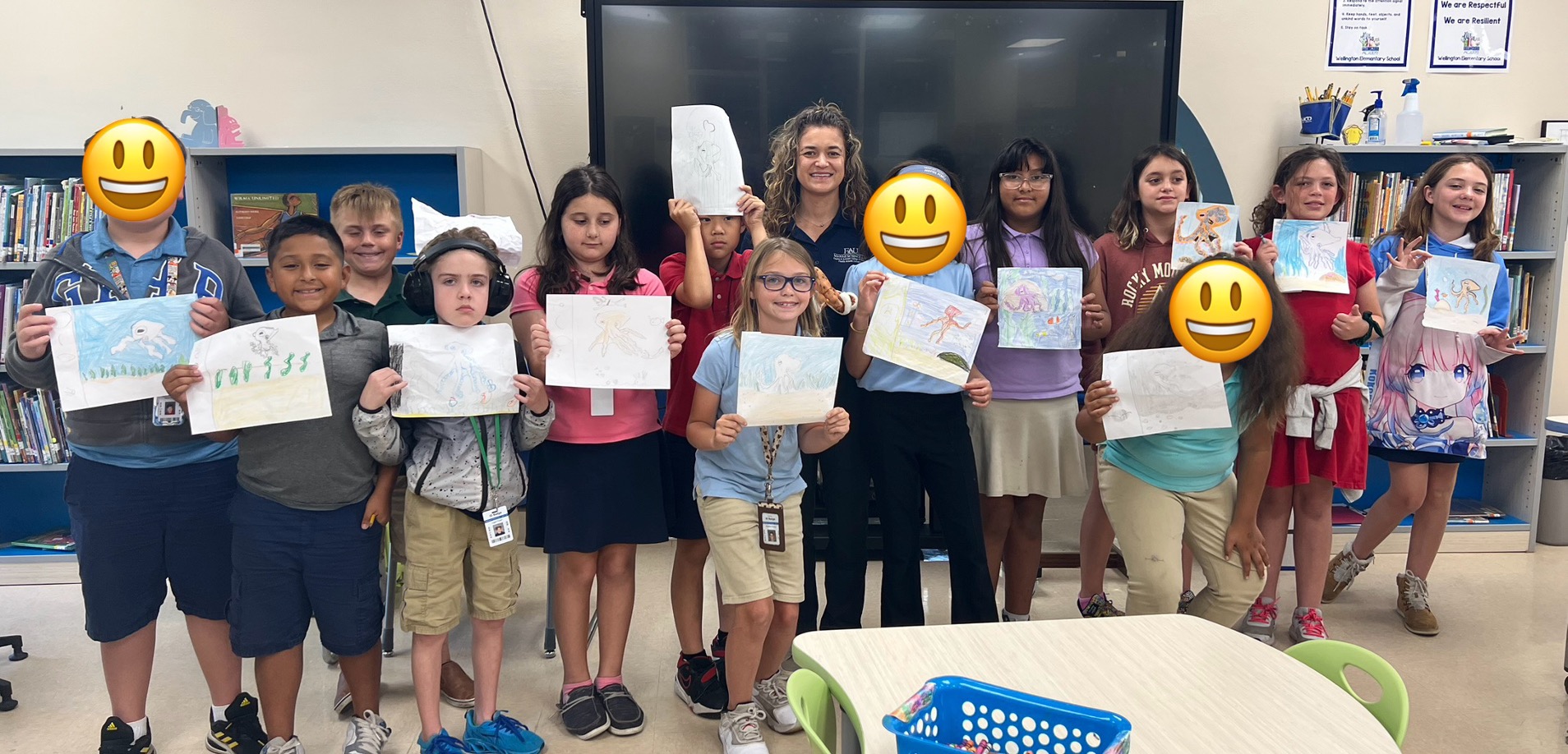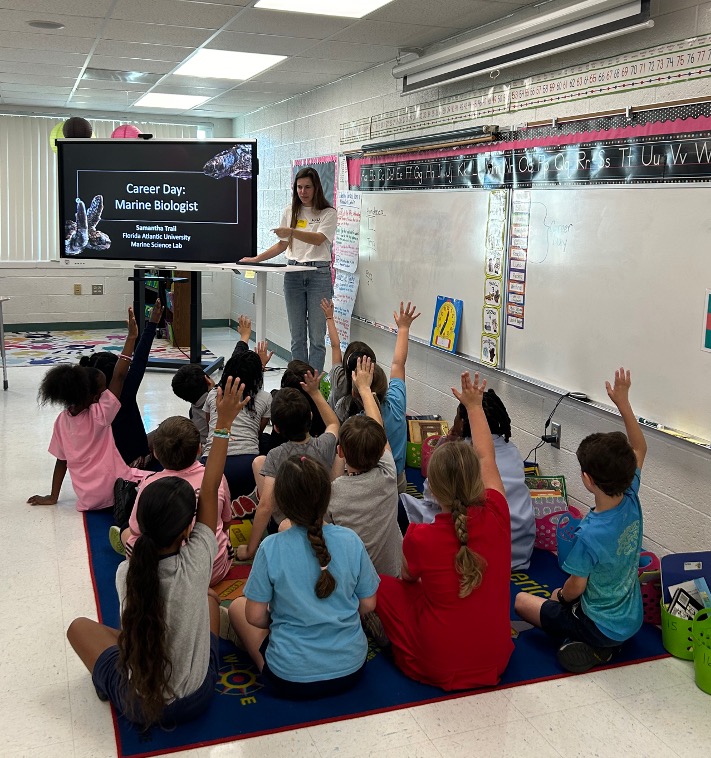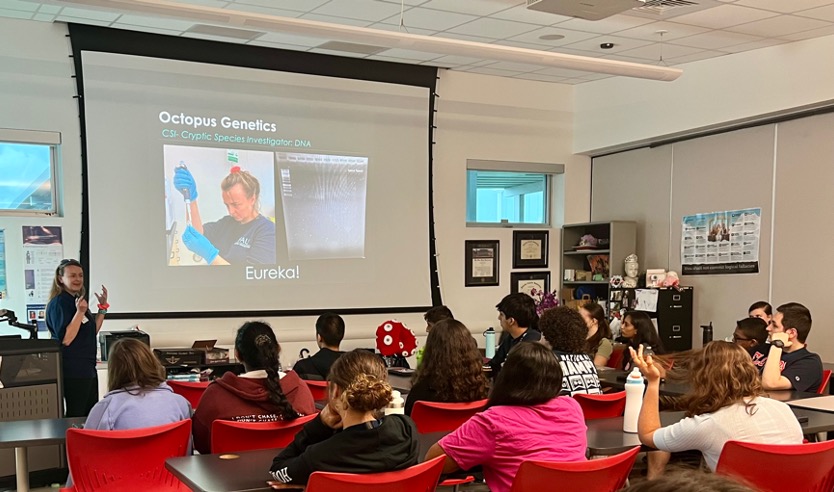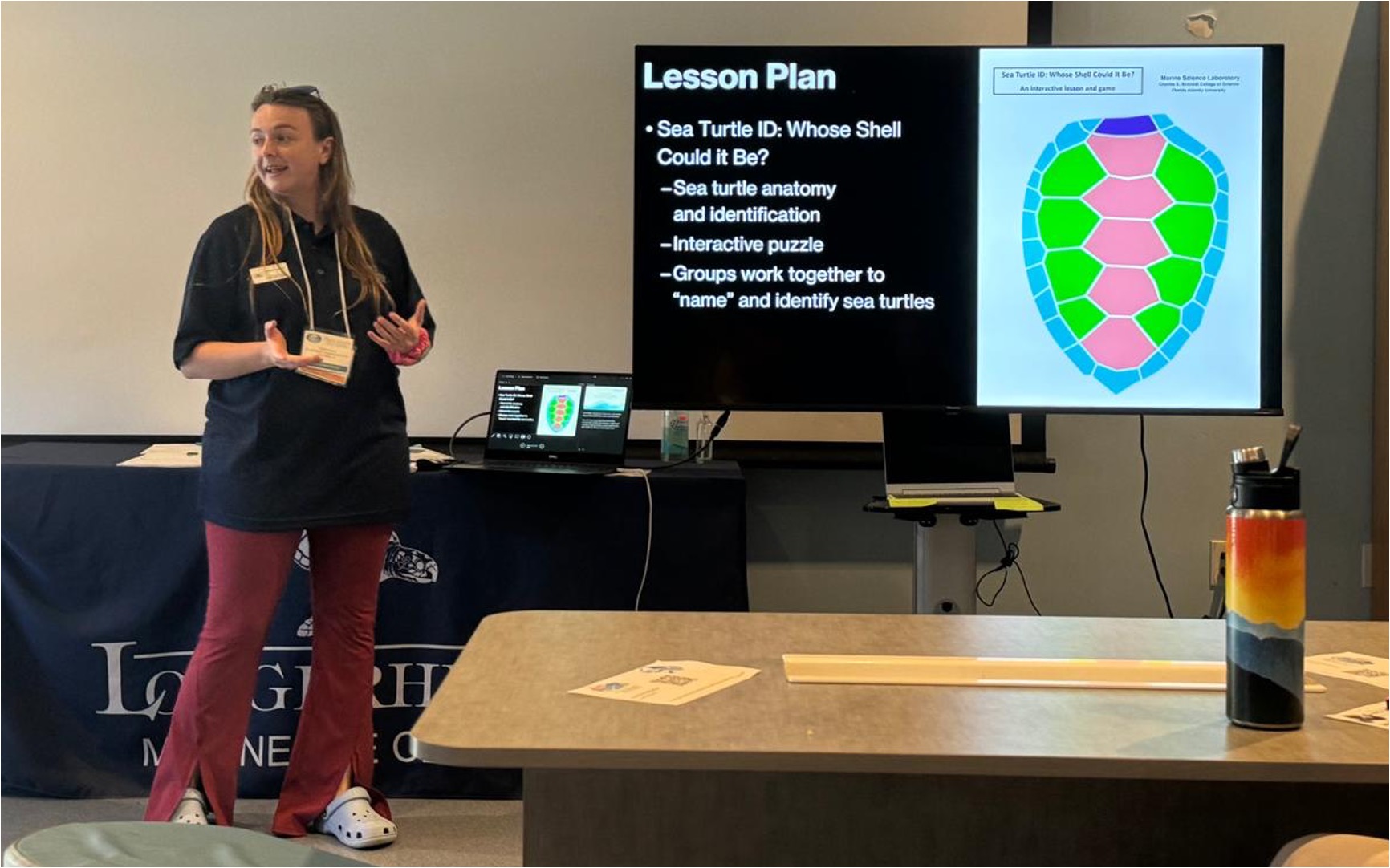
Authors: Dr. Chelsea Bennice, Colleen Hecker, Sam Trail
Date: May 24, 2024
As part of our mission to enhance science communication to broad audiences, the Glenn W. & Cornelia T. Bailey Marine SEA Scholars find themselves out in the community a lot, but this spring, they found themselves inside some local schools! From drawing ink-redible octopuses with fourth graders to competitive sea turtle ID games with teachers, we are finding unique ways to engage with local classrooms!
Draw an Octo with Wellington Elementary School’s Marine Biology Club
SEA Scholar Postdoc, Dr. Chelsea Bennice, brushed up on her drawing skills for an interactive octopus lesson with the Wellington Elementary School 4th grade marine biology club in April (pictured at the top of this article). First, she took them on a virtual dive to her favorite octopus spot, Lake Worth Lagoon, to introduce the future marine biologists to the different octopuses found in south Florida. Next, Dr. Bennice led the group through an activity How to draw an octopus with guided instructions to draw the octopus’s anatomy, adding octopus facts throughout the activity. Did you know octopuses have eight arms and no tentacles? Octopus arms are fully lined with suckers, whereas tentacles only have suckers at the distal tip (very end of the tentacle). Octopuses use their arms for cleaning, foraging, feeding, defense, and communication. Tentacles are mainly used for feeding. Squids and cuttlefishes have eight arms and a pair of feeding tentacles. After everyone drew their octopus in a habitat of their choice, they wrapped up the lesson by watching a short video about Inky the Octopus (the octopus that escaped from the Australian Aquarium) and sharing their favorite new octopus fact. We’d say it was an ink- redible time!
Career Day with Morikami Park Elementary School
In February, SEA Scholar Sam Trail was invited to Morikami Park Elementary for Career Day! She met with lots of second graders, excited to hear about what it is like to be a marine biologist. Sam first connected with the students by sharing her interests when she was in second grade, and many students shared those same interests. For example, when asked “How many of the students like animals?”, just about every hand in the room shot up with enthusiasm! Sam then explained the winding path that led her to study sea turtles and what her days look like as a Ph.D. student at the FAU Marine Lab – monitoring nests, caring for tiny turtles, and studying how they swim. Students were able to see and feel a real sea turtle shell and were shocked to realize the spine is incorporated into that bony shield! Finally, these inquisitive second graders practiced making scientific observations by comparing pictures and videos of different sea turtle species in our care at the FAU Marine Lab. The students’ curiosity was contagious, as they seemingly had more questions than minutes left in the day. We are pretty sure that on that day, there were present some young marine biologists in the making!

The Path to Research and Octo-topics with FAU High School’s Research Class
Marine Lab scientists and SEA Scholars, Colleen Hecker and Dr. Chelsea Bennice, have been busy at the Florida Atlantic University High School’s (FAUH) Imaging Lab, scanning and imaging octopus’ beaks and radula (a toothed ribbon-like tongue) for their research project: Who’s who in the south Florida Lagoon? Both the genetics and the morphology of octopus are important in species identification. Octopus species can be identified by their beaks and radula – think of it like dental records! With all this science action taking place at FAUH, Colleen and Dr. Bennice were invited to visit Dr. Amy Tift’s research class at FAUH in May. They shared their career paths and dived into their octo-topics: octopus behavior, skin microbiome, and genetics. Colleen showed closeup images of the radula’s teeth (which are microscopic) and passed around a 3D model of a squid’s upper and lower beaks, all created at the FAU Imaging Lab! Dr. Bennice brought her field research equipment to show the students innovative ways to collect data; this included the floating lab and the Octopus Monitoring Gadget – OMG! The students were fascinated by the research!

Florida Marine Science Educators Association 2024 Conference
In addition to our school visits, the FAU Marine Lab was an exhibitor at the Florida Marine Science Educators Association's 2024 conference, hosted by Loggerhead Marinelife Center of Juno Beach. We showcased our research and unveiled our new educational materials to 120 attendees, including teachers and other educators from all over Florida. FAU Marine Lab’s Colleen Hecker walked attendees through various materials, such as interactive, 3D models of green and leatherback sea turtles, virtual lesson experiences, and coloring sheets. It then was time for a bit of fun with the premiere of our lesson plan, Sea Turtle ID: Whose Shell Could It Be? An Interactive Lesson and Game. Colleen gave the educators an overview of sea turtle shell morphology, demonstrating the various shell characteristics that allow researchers to distinguish between sea turtle species. For example, loggerhead and green sea turtles have differing numbers of scutes (shell segments). The attendees solved an interactive sea turtle puzzle (complete with scute puzzle pieces) as they followed along with the lesson.

After learning about sea turtle shell morphology, the educators dove deeper into the lesson as Colleen taught them how scute shape and number help FAU Marine Lab personnel identify individual turtles in our care. Using non-toxic nail polish, our lab paints each sea turtle's scutes in a unique fashion, giving them an individual identification code or name. This helps us track the health of hundreds of individual sea turtles in our care! The demonstration ended with Colleen leading the group in a game; attendees had the chance to walk in the shoes of FAU Marine Lab researchers by naming a sea turtle according to the convention used by our lab. Using a sea turtle shell template, the attendees named their turtle by coloring the scutes on their turtle. In pairs, participants then asked series of questions to see if they could identify their partner's turtle, similar to the game "Guess Who?" The lesson plan was a hit, with teachers expressing an interest in integrating the lesson into their curricula.
As our mission centers around research, education, and communication, introducing our educational materials to Florida educators and connecting with students is a significant step in expanding our reach beyond the walls of the FAU Marine Lab. We are excited to continue engaging with our local schools!